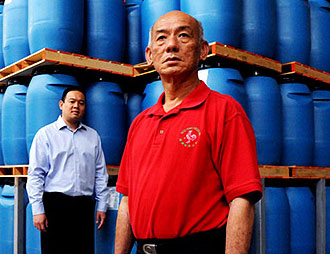When we started spotting bottles of Sriracha sauce at decidedly non-ethnic restaurants and markets, we knew it was time to meet the mind behind the big green-capped bottle that’s starting to replace ketchup on America’s hottest tables.
Problem is, David Tran, the 65-year-old Vietnamese American founder of Huy Fong Foods of Rosemead, California isn’t eager to have the world dip too deeply into the origin of his sauce. One reason may be that, to some extent, its burgeoning sales is based on a happy misconception that Tran may not be eager to correct.
Most people know Tran’s hot sauce as the Sriracha sauce. That’s the most prominent word on the front of the plastic bottles that hold over a pint of the red puree of chili peppers, vinegar, sugar, garlic and salt. Strictly speaking, Tran is misappropriating the name of a Thai sauce named after the beach town of Si Racha in central Thailand. The real sriracha sauce originated as a much thicker, sweeter and tangier paste for use as a seafood dip at local restaurants. The thinner Huy Fong version is usually squirted into bowls of pho and sometimes onto burgers and other foods.
Tran’s sriracha also isn’t the first commercial chili sauce by that name. That title belongs to a Thai company named Sriracha Panich which was acquired by Thai Theparos Foods and sells the sauce under the Golden Mountain brand. If that company moves into the U.S. market with the “Sriracha” brand, a trademark dispute would center around the origin of Tran’s claim to the name associated with his sauce sultunate.
Such abstract concerns haven’t kept David Tran’s Huy Fong Foods Inc from bursting at the seams. In October of 2010 its operations were so cramped for manufacturing space that it signed a deal to build a $40-million 655,000 square-foot headquarters and factory with the City of Irwindale. That’s the biggest new construction started this year in the entire County, according to the LA Times. The City was so eager to snag a big new employer, it’s financing the $15-mil. purchase price for the lot.
Tran’s success has already inspired rival companies to squeeze into the “sriracha” niche. Even the rooster logo and the big clear plastic bottles with bright plastic squirt caps have come under assault. Asian markets often stock several brands of sriracha sauces bearing animal logos ranging from a Vietnamese phoenix, a Chinese shark, a Thai flying goose and even a Thai “cock”. Consumers often do confuse these products with Huy Fong’s. The difference in taste among these brands isn’t always apparent, though David Tran might hotly dispute that assessment.
Tran was a sauce maker since 1975 back in his native Vietnam, he told the New York Times. He used peppers grown on his older brother’s farm in a town north of Saigon. The sauces he made there were a far cry from the one that has become an Asian American household word. He was selling an oil-based sauce in recycled Gerber baby food jars obtained from U.S. military bases. He sold batches to jobbers who distributed them to stores in the region. It became popular as the ideal condiment for roast dog.
By 1979 Tran had saved enough from his business to buy his family’s passage out of Vietnam. After a period of waiting in Southeast Asia for the UN Refugee Agency to resettle them, the family made its way to the U.S. Tran resumed his sauce-making business in a 2,500 square-foot space in Los Angeles Chinatown in February of 1980.
“I remember seeing Heinz 57 ketchup and thinking, ‘The 1984 Olympics are coming. How about I come up with a Tran 84, something I can sell to everyone?’” Tran recalls.
Tran doesn’t dwell on the thinking behind taking the sriracha name for the sauce he decided to produce. The emerging popularity of Thai restaurants around that time probably had something to do with it. But he does recall buying his peppers at Grand Central Market and delivering his bottles in a Chevy van. It was natural that his first sales successes were in the pho shops that had begun sprouting up in and around Orange County, especially the emerging Little Saigon of Westmister and Garden Grove.
In 1996 Huy Fong Foods expanded into his current Rosemead plant, then bought a nearby warehouse once used by Wham-O for frisbees and hula-hoops. Currently the company has grown to annual sales of around $35 million on about 20 million bottles of hot sauce. But about 80% of Huy Fong’s sales continue to be to Asian American outlets and the company remains a family affair, employing eight family members and a total of 70 seasonal manufacturing workers. Tran’s 33-year-old son William is now the company president.
The popularity Huy Fong’s sriracha sauce has since attained as a way to spice up everything from burgers to sushi took Tran by surprise. During the past two years chefs at restaurants from Appleby’s to the most chi chi Manhattan bistros have begun proclaiming their devotion to sriracha sauce as a secret ingredient of some of their dishes. More importantly from considerations of sheer sales volume is its recent jump from ethnic markets like Ranch 99 to generic outlets like Wal-Mart and major regional supermarket chains.
At this point demand is so strong that the only thing holding back an immediate tripling of production is lack of space. In fact, once the business moves into the new Irwindale building it will begin ramping up manufacturing capacity tenfold by 2016 just to keep up with backlogged demand.



